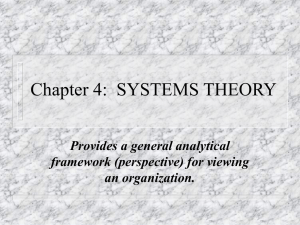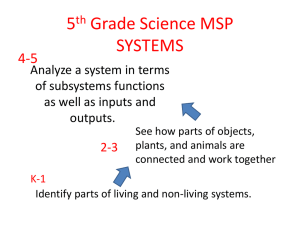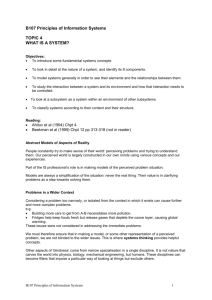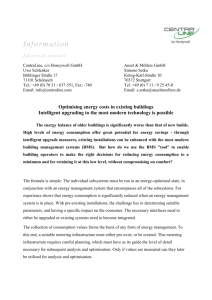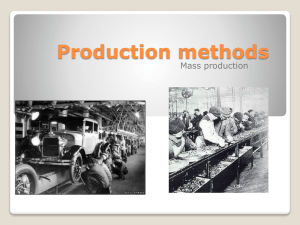Estimation of distribution parameters, Complex systems
advertisement
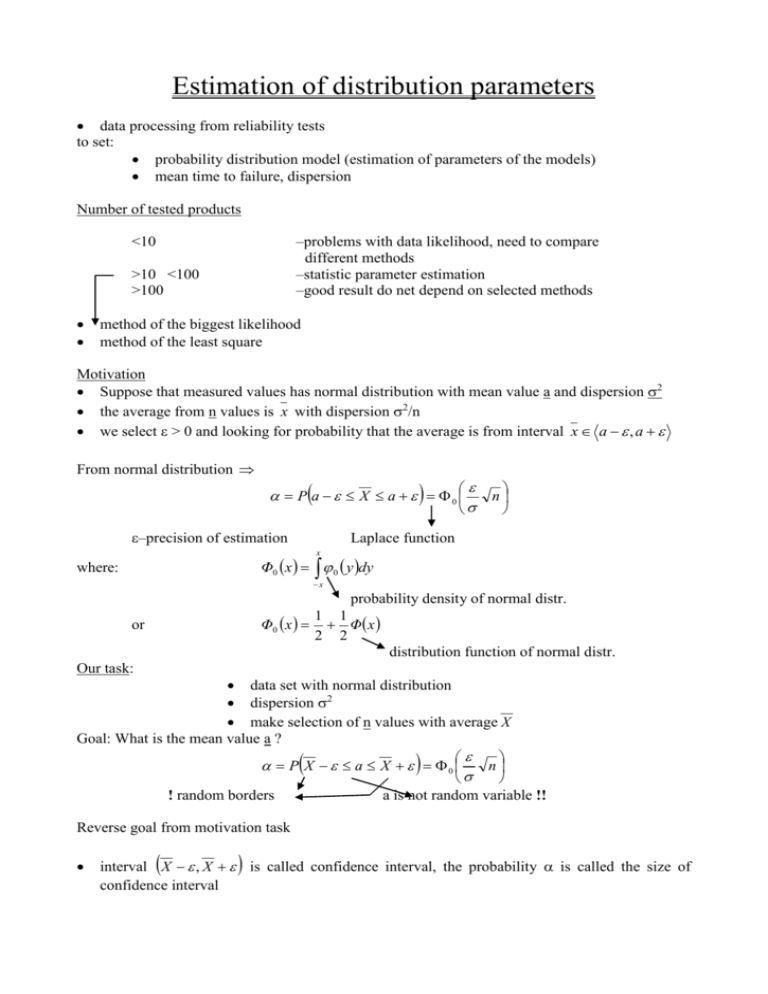
Estimation of distribution parameters data processing from reliability tests to set: probability distribution model (estimation of parameters of the models) mean time to failure, dispersion Number of tested products –problems with data likelihood, need to compare different methods –statistic parameter estimation –good result do net depend on selected methods <10 >10 <100 >100 method of the biggest likelihood method of the least square Motivation Suppose that measured values has normal distribution with mean value a and dispersion 2 the average from n values is x with dispersion 2/n we select > 0 and looking for probability that the average is from interval x a , a From normal distribution P a X a 0 –precision of estimation n Laplace function x Φ0 x 0 y dy where: x probability density of normal distr. Φ0 x or 1 1 Φx 2 2 distribution function of normal distr. Our task: data set with normal distribution dispersion 2 make selection of n values with average X Goal: What is the mean value a ? P X a X 0 n ! random borders a is not random variable !! Reverse goal from motivation task interval X , X is called confidence interval, the probability is called the size of confidence interval Remark: confidential interval can be limited from one size, it means.: Pa ad 1 Pa ah 2 with previous equations we receive equation for , 1 and 2 : Pa ad Pa ah 1 1 2 1 2 1 f(x) 2 ah x f(x) x ad ah Confidence interval limited by one side (above) or by two sides Remark: for unknown distribution can be used raw estimation with Tchebyshev inequality. It can (down) 2 be prove, that for random variable X with mean value E(X) and dispersion D ( X ) this equation is true for all k>0: P X E X .k 1 k2 for x Ex is 3 time worst than boundaries for normal distribution for x Ex 3 is 40 time worst than boundaries for normal distribution Graph methods: exists graphic methods for estimation of distribution – depending of failure rate Reliability of complex systems decomposition of complex systems (it is easier to detect the reliability of subsystems) analysis of structure and mutual connections: usually it is assumed that the failures of subsystems are independent dependent failures in subsystems with interaction to another subsystems or with interaction in common environment Remark: if nothing else is specified we suppose this limitation to simplification the evaluation: every system (and all its subsystems) are in state of working or in state of failure (there is no third state) probability of working without failure is constant in time systems are without repair Serial system: all subsystems works the whole system is working failure of at least one subsystem leads to failure of the whole system Input a1 a2 an Input a1 a2 an Output Output Flow chart and graph representation of serial system Direction of signals (in general it is oriented multigraph) Suppose: n…is a number of subsystems X i …state failure of i-th subsystem X i …working state of i-th subsystem the corresponding probabilities are P X i , P X i Probability of working without failure (intersection of working states of all subsystems) for dependent subsystems R Px1 Px2 | x1 Px3 | x1 x2 Pxn | x1 x2 ...xn1 If the subsystems are independent: n R P xi i 1 Probability of failure subsystem that has the failure: Q P x1 x2 ... xn (union of failure states) failure states are not mutually excluded the equation can be changed: n n Q P xi P xi x j ... 1 i 1 i 1 j 1 i j n 1 P x1 x2 ...xn : together 2n-1 items sum of probabilities of all combinations 3…(n-1) Conclusion: It is better to calculate probability of working without failure and the probability of failure calculate from Q = 1 – R. Serial system has always worst reliability then is the reliability of the worst subsystem If the system is composed form n identical subsystems with the same probability of working without failure p and probability of failure is q n probability of working without failure is : R p n 1 q Probability of failure: Q 1 p n 1 1 q n Parallel system Input a1 Output a1 a2 a2 an … Input Output an Flow chart and graph representation of parallel system parallel system is working without failure <=> at least one subsystem is working without failure (so called redundant connection => increase reliability of system) probability of working without failure: (union of state working for subsystems) R = P(x1+x2+x3+ … +xn) By analogy with serial system the equation is changed: R P( x1 ) P( x2 ) ... P( xn ) [ P( x1 , x2 ) P( x1 , x3 ) ... ... P( xi , x j )] ... (1) n1 P( x1 x2 ... xn ) i j failure of parallel system is if there is failure of all subsystems: intersection of state failure of subsystems Q P( x1 x2 x3 ...xn ) for dependent subsystems: Q P( x1 ) P( x2 x1 ) P( x3 x1 x2 )...P( xn x1 x2 ...xn1 ) for independent subsystems: n Q P ( xi ) i 1 Conclusion: probability of working without failure of parallel system is always higher (better) then the probability of working without failure of the best subsystem for parallel system of identical independent subsystems with the same probability of failure q: probability of failure: Q q n (1 p) n probability of working without failure: R (1 q n ) 1 (1 p) n Combined systems: solution of complex systems (1) transformation to combination of serial and parallel systems – FAST (2) partially transformation with (1) followed by specific computation Another types of system systems of type "m from n" n system components for correct work you need m working components Example: rope created from n fibers. To desired carrying capacity is necessary at least m<n not broken fibers Example 2: (system "m from n") system of water-stations with common distribution network h model of this system has parallel connections input → output m every connection has m-components in serial system (one combination / selection from n components) System is working without failure <=> at least one connection is working If we suppose identical independent components => binomial distribution it means that probability of working without failure: Probability of working p. components R n f (k , n, p) k m extreme case: for m = 1 (at least one from n) ≡ parallel system for m = n (n from n) ≡ serial system Solving the system reliability using index: Principle: (1) create index of all possible cases of events (3) index there are only isolated events correct and adverse Σ probabilities of all Σ probabilities of adverse correct events (state of events correct working) (state of failure) Example: a Input d Output b c e Flow chart of example system number of subsystems = 5 => 2n = 25 = 32 possible events allocation to group with fixed number of working subsystems: Number of failures in system 0 1 2 4 5 A1 = A2 = A3 = A4 = A5 = A6 = A7 = A8 = A9 = … abcde a bcde ab cde abc de abcd e abcde abcde abc de a bcd e System is working without failure yes yes yes yes yes yes yes yes yes … A27= abcde A28= abcde A29= abcde A29= abcd e no no no no A31= abcde A32= abcde no no Sum: Failure: 13 combination Working without failure: 19 combination 5 no failure events, one failure 0 Probability of failure is: 5 events, 5 failures 1 5 events 5 Q P( A16 A17 A18 A20 A21 A24 A26 A27 A28 A29 A30 A31 A32 ) because states A1…A32 are mutually excluded => the probability of the union is sum of the probabilities two possibilities for computation prob. of working without failure: R 1 Q 1 [ P( A16 ) P( A17 ) ... P( A32 )] Σ of correct independent states from index according to probability of failure. Special case: the system with identical subsystems with probability of working without failure p R 1 Q 1 [ p 3 (1 p) 2 6 p 2 (1 p)3 5 p(1 p) 4 (1 p)5 ] Remark.: (1) Probability of working without failure can be calculated as R=P(union of events of correct working) (2) in practice is selected computation of P or Q depending on number of failure states Disadvantage of this approach is the combinatory explosion for bigger systems

